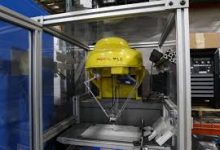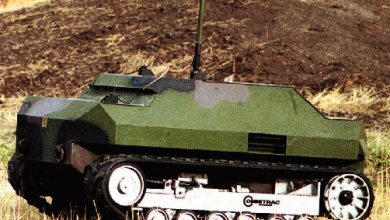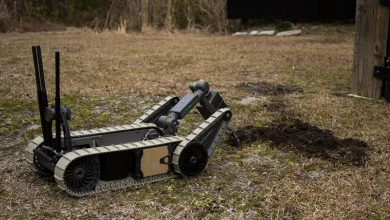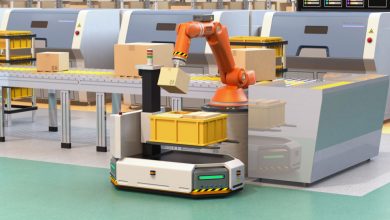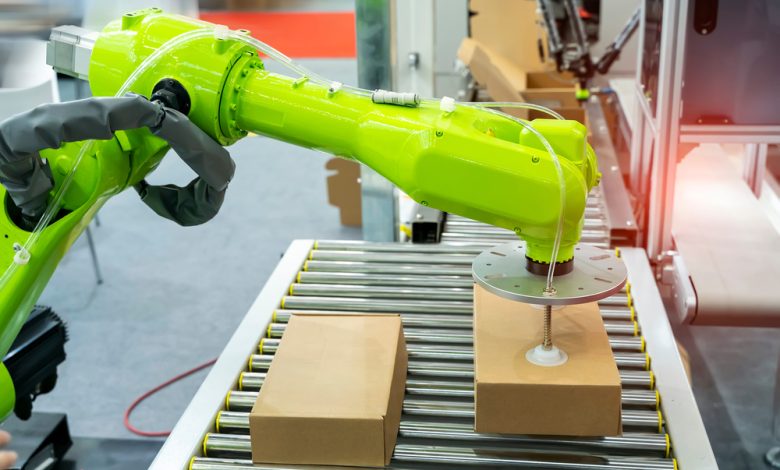
Introduction:
In the ever-evolving landscape of technology, robotics stands at the forefront of innovation. Among the myriad branches of robotics, articulated robotics emerges as a fascinating realm, offering unprecedented versatility and functionality. From manufacturing industries to healthcare, from exploration to entertainment, articulated robots are revolutionizing various sectors, reshaping the way we work, interact, and perceive automation.
What are Articulated Robots?
Articulated robots, also known as robotic arms, are mechanical devices designed to mimic the dexterity and flexibility of the human arm. Comprising multiple segments or joints connected by actuators, these robots can move along multiple axes, enabling them to perform intricate tasks with precision and efficiency. Each joint provides a degree of freedom, allowing the robot to navigate through complex motions and adapt to diverse environments.
The Anatomy of Articulated Robots:
Articulated robots typically consist of several key components:
1. Base:
The base serves as the foundation of the robot, providing stability and support. It houses the mechanisms for rotation and movement along the vertical axis, allowing the robot to orient itself in space.
2. Joints:
Articulated robots feature multiple joints, each facilitating movement along a specific axis. These joints may include revolute joints for rotational motion, prismatic joints for linear motion, and even specialized joints for more complex maneuvers.
3. Links:
The segments connecting the joints are known as links. These links vary in length and can be rigid or flexible, depending on the intended application. They determine the reach and range of motion of the robot.
4. End Effector:
The end effector, or tooling, is the component attached to the end of the robot’s arm. It is responsible for interacting with the environment, whether it be gripping objects, welding components, or performing precise surgical procedures.
Applications of Articulated Robotics:
The versatility of articulated robots lends itself to a wide range of applications across various industries:
1. Manufacturing:
Articulated robots play a pivotal role in automation within manufacturing facilities. From assembly lines to material handling, these robots excel in tasks that require speed, accuracy, and repeatability. They can be programmed to perform intricate maneuvers such as welding, painting, and soldering with utmost precision.
2. Healthcare:
In the field of healthcare, articulated robots are revolutionizing surgery and patient care. Surgical robots, equipped with advanced imaging and instrumentation capabilities, enable surgeons to perform minimally invasive procedures with enhanced precision and control. Additionally, rehabilitation robots assist patients in recovering motor functions after injuries or surgeries, providing personalized therapy sessions.
3. Exploration:
Articulated robots are indispensable tools in exploration missions, both on Earth and in space. Robotic arms deployed on rovers and spacecraft facilitate scientific research and exploration in remote and hazardous environments. They can collect samples, manipulate objects, and conduct experiments with unparalleled accuracy, expanding our understanding of the universe.
4. Service and Hospitality:
With the rise of automation in service industries, articulated robots are making their mark in hospitality and customer service. From robotic bartenders and waitstaff to concierge robots in hotels, these machines enhance efficiency and convenience while providing a unique and futuristic experience for patrons.
Challenges and Future Directions:
While articulated robotics holds immense potential, it also poses certain challenges and limitations. One such challenge is the need for robust programming and control algorithms to ensure safe and efficient operation in dynamic environments. Additionally, advancements in materials science and sensor technology are crucial for enhancing the capabilities and reliability of articulated robots.
Looking ahead, the future of articulated robotics is filled with promise. Continued research and development efforts are expected to yield more compact, agile, and intelligent robotic systems capable of performing increasingly complex tasks with autonomy and adaptability. Collaborative robots, or cobots, are anticipated to play a significant role in human-robot interaction, fostering seamless collaboration and enhancing productivity across various domains.
Conclusion:
Articulated robotics represents a cornerstone of technological innovation, offering boundless possibilities for enhancing efficiency, precision, and versatility across diverse industries. From the factory floor to the operating room, from the depths of the ocean to the expanse of outer space, articulated robots are reshaping the way we work, explore, and interact with our world. As we continue to push the boundaries of robotics technology, the era of intelligent automation heralds a future where human and machine collaborate harmoniously to achieve remarkable feats of innovation and discovery.
Articulated Robotics: The Evolution of Precision and Versatility in Automation
Introduction:
In the vast landscape of robotics, articulated robotics stands as a testament to human ingenuity and innovation. These sophisticated machines, inspired by the intricacies of the human arm, have redefined automation across various industries. From manufacturing and healthcare to exploration and entertainment, articulated robots have emerged as indispensable tools, capable of performing a myriad of tasks with precision and efficiency. In this comprehensive exploration, we delve into the intricacies of articulated robotics, exploring their anatomy, applications, challenges, and future prospects.
Understanding Articulated Robotics:
Articulated robots are mechanical systems comprised of multiple segments or links connected by joints. These joints, often actuated by motors or pneumatic systems, enable the robot to move along multiple axes with precision and fluidity. By manipulating these joints, articulated robots can perform a wide range of motions, from simple pick-and-place tasks to complex maneuvers requiring intricate coordination and control.
The Anatomy of Articulated Robots:
An articulated robot consists of several key components, each playing a crucial role in its functionality:
1. Base:
The base serves as the foundation of the robot, providing stability and support. It houses the mechanisms for rotation and movement along the vertical axis, allowing the robot to orient itself in space.
The Foundation of Precision: Exploring the Articulated Robotics Base
Introduction:
In the intricate world of articulated robotics, the base serves as the cornerstone upon which the entire structure is built. It is the foundation that provides stability, support, and the ability to maneuver in space. Often overlooked in favor of more glamorous components, the base is a critical element that determines the robot’s range of motion, payload capacity, and overall performance. In this comprehensive exploration, we delve into the anatomy, functionality, and significance of the articulated robotics base, shedding light on its essential role in driving innovation and advancing automation.
Anatomy of the Articulated Robotics Base:
The base of an articulated robot comprises several key components, each playing a vital role in its functionality:
1. Mounting Structure:
At the heart of the base lies the mounting structure, which serves as the interface between the robot and its environment. This structure is typically made of sturdy materials such as aluminum or steel and is designed to provide rigidity and durability. It houses the various mechanisms and components necessary for the robot’s operation, including motors, gears, and sensors.
2. Rotation Mechanism:
One of the defining features of the articulated robotics base is its ability to rotate, allowing the robot to orient itself in space and access different areas within its workspace. The rotation mechanism may consist of a motorized turntable or a series of gears and bearings that enable smooth and precise rotation. The range of rotation can vary depending on the robot’s design and application requirements, ranging from a few degrees to a full 360-degree rotation.
3. Vertical Movement Mechanism:
In addition to rotation, some articulated robots are equipped with a vertical movement mechanism that allows them to adjust their height or elevation. This mechanism may involve the use of pneumatic cylinders, hydraulic actuators, or linear motion systems such as ball screws or belts. By incorporating vertical movement capabilities, the robot can adapt to different workpieces and optimize its reach and accessibility.
4. Base Sensors:
To ensure safe and efficient operation, many articulated robots are equipped with sensors embedded within the base. These sensors may include proximity sensors, encoders, and limit switches that provide feedback on the robot’s position, speed, and orientation. By continuously monitoring these parameters, the robot can detect obstacles, avoid collisions, and maintain precise positioning accuracy.
Functionality and Significance:
The articulated robotics base serves several critical functions that are essential for the robot’s overall performance and effectiveness:
1. Stability and Support:
The primary function of the base is to provide a stable and secure platform for the robot’s operation. By anchoring the robot to the ground or mounting surface, the base minimizes vibrations, oscillations, and other disturbances that could affect the robot’s accuracy and repeatability. This stability is crucial for tasks that require precise positioning and manipulation, such as assembly, welding, and machining.
2. Range of Motion:
The base’s rotation mechanism enables the robot to achieve a wide range of motion, allowing it to access different areas within its workspace without having to physically move its entire structure. This versatility is invaluable for applications that require the robot to reach around obstacles, manipulate objects from multiple angles, or work in confined spaces where traditional linear motion systems are impractical.
3. Accessibility:
By incorporating vertical movement capabilities, the articulated robotics base enhances the robot’s accessibility and versatility. It allows the robot to adjust its height or elevation to accommodate different workpieces, tools, and fixtures, ensuring optimal positioning and alignment during operation. This flexibility is particularly beneficial in manufacturing environments where workpieces vary in size, shape, and orientation.
4. Adaptability:
The base sensors play a crucial role in enhancing the robot’s adaptability and responsiveness to changes in its environment. By providing real-time feedback on the robot’s position and orientation, these sensors enable the robot to adjust its trajectory, speed, and acceleration to avoid obstacles, navigate complex paths, and maintain precise positioning accuracy. This adaptability is essential for ensuring safe and efficient operation in dynamic and unpredictable environments.
Future Directions and Innovations:
As the field of robotics continues to evolve, the articulated robotics base is poised to undergo significant advancements and innovations:
1. Integration of Advanced Sensors:
Future articulated robots may feature advanced sensor technologies such as LiDAR, depth cameras, and force/torque sensors integrated directly into the base. These sensors will provide enhanced perception capabilities, enabling the robot to perceive and interact with its environment more effectively. This will expand the robot’s range of applications and enable new capabilities such as collaborative manipulation and autonomous navigation.
2. Modular Design:
To enhance flexibility and scalability, future articulated robots may adopt a modular design approach for the base. This will allow users to customize the robot’s configuration based on their specific requirements, easily adding or removing components such as rotation platforms, vertical actuators, and sensor modules. Modular design will also facilitate easier maintenance and upgrades, reducing downtime and overall lifecycle costs.
3. Enhanced Control and Navigation Algorithms:
Advances in control and navigation algorithms will enable articulated robots to perform more complex tasks with greater autonomy and efficiency. Future robots will leverage machine learning, artificial intelligence, and predictive analytics to optimize their motion planning, trajectory generation, and obstacle avoidance capabilities. This will result in smoother, more natural movements, improved energy efficiency, and faster cycle times.
4. Collaborative Operation:
With the rise of collaborative robotics, future articulated robots will be designed to work seamlessly alongside human operators in shared workspaces. The base will incorporate safety features such as collision detection, force limiting, and proximity sensing to ensure safe interaction between humans and robots. This will enable new applications in human-robot collaboration, such as collaborative assembly, co-robotic welding, and mixed-initiative manipulation.
Conclusion:
The articulated robotics base is a critical component that underpins the functionality and performance of articulated robots. By providing stability, support, and motion capabilities, the base enables robots to achieve precise positioning, accessibility, and adaptability in a wide range of applications. As robotics technology continues to advance, the base will undergo continuous innovation and refinement, driving new capabilities, efficiencies, and opportunities for automation across various industries. By harnessing the power of the articulated robotics base, we can unlock new frontiers of productivity, innovation, and human-machine collaboration, shaping the future of automation in profound and transformative ways.
2. Joints:
The joints are pivotal points where the robot’s links connect, enabling rotational or linear motion. These joints can vary in type, including revolute joints for rotational movement and prismatic joints for linear motion. Additionally, some robots feature specialized joints such as spherical or cylindrical joints for added flexibility.
Unraveling the Mechanics: A Deep Dive into Articulated Robotics Joints
Introduction:
In the realm of robotics, articulated joints are the unsung heroes that enable machines to move with precision and grace, mimicking the flexibility and dexterity of the human body. These mechanical marvels serve as the building blocks of articulated robots, allowing them to perform a myriad of tasks with accuracy and efficiency. In this extensive exploration, we delve into the anatomy, mechanics, and significance of articulated robotics joints, unraveling their role in driving innovation and shaping the future of automation.
Anatomy of Articulated Robotics Joints:
Articulated robotics joints come in various forms, each offering unique capabilities and degrees of freedom. Some of the most common types of joints include:
1. Revolute Joint:
The revolute joint, also known as a rotary joint, enables rotational motion around a fixed axis. This type of joint is analogous to the human elbow or knee joint and is widely used in articulated robots to facilitate bending and rotation of the robot’s limbs. Revolute joints typically consist of a motorized actuator connected to a shaft or pivot point, allowing the robot to rotate its segments with precision and control.
2. Prismatic Joint:
The prismatic joint, also referred to as a linear joint, enables translational motion along a fixed axis. This type of joint is analogous to the human shoulder or hip joint and is commonly used in articulated robots to facilitate linear movement of the robot’s limbs. Prismatic joints typically consist of a motorized actuator connected to a sliding mechanism, allowing the robot to extend or retract its segments along a straight path.
3. Spherical Joint:
The spherical joint, also known as a ball joint, enables rotational motion around multiple axes simultaneously. This type of joint is analogous to the human wrist joint and provides greater flexibility and range of motion compared to revolute joints. Spherical joints are often used in articulated robots to facilitate complex maneuvers and manipulations, such as grasping objects from multiple angles or navigating tight spaces.
4. Universal Joint:
The universal joint, also referred to as a Cardan joint, enables rotational motion around two perpendicular axes. This type of joint is commonly used in articulated robots to facilitate rotation and tilting of the robot’s end effector. Universal joints provide greater freedom of movement compared to revolute joints and are often employed in applications requiring precise orientation control, such as welding, painting, and machining.
Mechanics and Functionality:
The mechanics of articulated robotics joints are governed by principles of kinematics and dynamics, which dictate the relationship between the joint’s inputs (e.g., motor torque, actuator displacement) and outputs (e.g., joint angle, end effector position). By understanding these mechanics, engineers can design articulated robots that move with precision, efficiency, and reliability.
1. Kinematics:
Articulated robotics joints are characterized by their kinematic properties, which describe how the joint’s position and orientation change as a function of time. Kinematic analysis involves studying the relationship between the joint’s inputs (e.g., motor commands) and outputs (e.g., joint angles), allowing engineers to determine the robot’s workspace, reachability, and trajectory planning capabilities.
2. Dynamics:
Articulated robotics joints are also subject to dynamic forces and torques that arise from interactions with the environment and internal mechanisms. Dynamic analysis involves studying the joint’s response to external forces and torques, as well as its ability to maintain stability, balance, and performance under various operating conditions. By understanding these dynamics, engineers can optimize the robot’s control algorithms, motor sizing, and mechanical design to enhance its performance and reliability.
Significance and Applications:
Articulated robotics joints play a crucial role in enabling robots to perform a wide range of tasks across various industries. Some of the key applications of articulated robotics joints include:
1. Manipulation:
Articulated robotics joints enable robots to manipulate objects with precision and dexterity, making them invaluable in manufacturing, assembly, and material handling operations. Robots equipped with revolute, prismatic, spherical, and universal joints can perform a wide range of manipulative tasks, such as picking, placing, grasping, and rotating objects of various shapes, sizes, and materials.
2. Mobility:
Articulated robotics joints enable robots to navigate through complex environments and terrain with agility and efficiency. Robots equipped with revolute and prismatic joints can traverse uneven surfaces, climb stairs, and negotiate obstacles with ease, making them ideal for applications such as search and rescue, exploration, and surveillance.
3. Human-Robot Interaction:
Articulated robotics joints enable robots to interact with humans and collaborate on tasks requiring coordination and cooperation. Robots equipped with revolute, spherical, and universal joints can perform collaborative tasks such as assisting with assembly, rehabilitation, and healthcare, where precise manipulation and interaction with human operators are essential.
Challenges and Future Directions:
Despite their significance and versatility, articulated robotics joints pose several challenges and opportunities for future research and development:
1. Kinematic Redundancy:
Articulated robots with multiple degrees of freedom may exhibit kinematic redundancy, where there are more joint variables than necessary to achieve a desired end effector position or orientation. Addressing kinematic redundancy requires developing advanced motion planning algorithms that optimize the robot’s trajectory while satisfying constraints such as joint limits, workspace limits, and obstacle avoidance.
2. Actuator Design:
Articulated robotics joints require robust and reliable actuators capable of generating the torques and forces necessary to move the robot’s limbs with precision and efficiency. Future research in actuator design may focus on developing lightweight, compact, and energy-efficient actuators that offer high torque density, fast response times, and low backlash.
3. Sensing and Feedback:
Articulated robotics joints require accurate and reliable sensors to provide feedback on the joint’s position, velocity, and torque. Future research in sensing and feedback may focus on developing advanced sensor technologies such as optical encoders, inertial sensors, and force/torque sensors that offer high resolution, low latency, and immunity to environmental disturbances.
Conclusion:
Articulated robotics joints are the mechanical marvels that enable robots to move with precision, versatility, and agility. By understanding the anatomy, mechanics, and significance of articulated robotics joints, engineers can design robots that perform a wide range of tasks across various industries, from manufacturing and mobility to human-robot interaction and collaboration. As robotics technology continues to evolve, articulated robotics joints will play an increasingly critical role in driving innovation and shaping the future of automation, enabling robots to perform tasks that were once considered impossible or impractical.
3. Links:
The links are the rigid segments connecting the joints, determining the robot’s reach and range of motion. These links can vary in length and material composition depending on the application requirements. Flexible links may also be utilized to accommodate greater adaptability and resilience in complex environments.
4. End Effector:
The end effector, or tooling, is the component attached to the end of the robot’s arm. It is responsible for interacting with the environment and performing specific tasks. End effectors come in various forms, including grippers, welding torches, cutting tools, and sensors, tailored to the robot’s intended application.
Applications of Articulated Robotics:
The versatility and precision of articulated robots have made them indispensable across a wide range of industries:
1. Manufacturing:
Articulated robots have revolutionized manufacturing processes, streamlining production lines and enhancing efficiency. From automotive assembly to electronics fabrication, these robots excel in tasks requiring speed, accuracy, and repeatability. They can handle diverse operations, including welding, painting, assembly, and packaging, with unparalleled precision and consistency.
2. Healthcare:
In the field of healthcare, articulated robots have transformed surgical procedures, enabling minimally invasive interventions with enhanced precision and control. Surgical robots, equipped with advanced imaging and instrumentation capabilities, allow surgeons to perform complex procedures with reduced trauma and faster recovery times. Additionally, rehabilitation robots assist patients in regaining motor function and mobility following injuries or surgeries, offering personalized therapy sessions tailored to individual needs.
3. Exploration:
Articulated robots are indispensable tools in exploration missions, both terrestrial and extraterrestrial. Robotic arms deployed on planetary rovers and spacecraft facilitate scientific research and exploration in remote and hazardous environments. They can collect samples, manipulate objects, and conduct experiments with unprecedented accuracy and reliability, expanding our understanding of the universe and paving the way for future exploration endeavors.
4. Service and Hospitality:
The integration of articulated robots into service industries has ushered in a new era of automation and convenience. From robotic bartenders and waitstaff to concierge robots in hotels and airports, these machines enhance efficiency and customer satisfaction while providing a unique and futuristic experience. With their ability to perform a wide range of tasks autonomously, articulated robots are poised to revolutionize the service and hospitality sectors, redefining the standards of quality and efficiency.
Challenges and Future Directions:
Despite their remarkable capabilities, articulated robots face several challenges and limitations:
1. Programming and Control:
The complexity of programming articulated robots to perform intricate tasks in dynamic environments remains a significant challenge. Developing robust control algorithms capable of adapting to unforeseen obstacles and changes in the environment is essential for ensuring safe and efficient operation.
2. Human-Robot Interaction:
As articulated robots become increasingly prevalent in shared workspaces, ensuring safe and seamless interaction between humans and robots is paramount. Collaborative robots, or cobots, equipped with advanced sensing and perception capabilities, are emerging as a promising solution to facilitate harmonious collaboration while maximizing productivity and safety.
3. Sensing and Perception:
Advancements in sensor technology are crucial for enhancing the situational awareness and perception capabilities of articulated robots. Integrating sensors such as cameras, LiDAR, and tactile sensors enables robots to perceive and respond to their surroundings with greater accuracy and efficiency, reducing the risk of collisions and improving task performance.
Looking ahead, the future of articulated robotics is filled with promise and possibility. Continued research and development efforts are expected to yield more compact, agile, and intelligent robotic systems capable of performing increasingly complex tasks with autonomy and adaptability. From the advent of soft robotics and bio-inspired designs to the integration of artificial intelligence and machine learning algorithms, the trajectory of articulated robotics points towards a future where human and machine collaborate seamlessly to achieve remarkable feats of innovation and discovery.
Conclusion:
Articulated robotics represents a pinnacle of technological achievement, offering unparalleled precision, versatility, and efficiency across a myriad of applications. From the factory floor to the operating room, from the depths of the ocean to the vast expanse of space, articulated robots continue to push the boundaries of what is possible, reshaping industries and transforming the way we live, work, and explore. As we embark on this journey of innovation and discovery, the era of articulated robotics promises to unlock new frontiers of human potential, ushering in a future where imagination knows no bounds and the possibilities are limitless.

